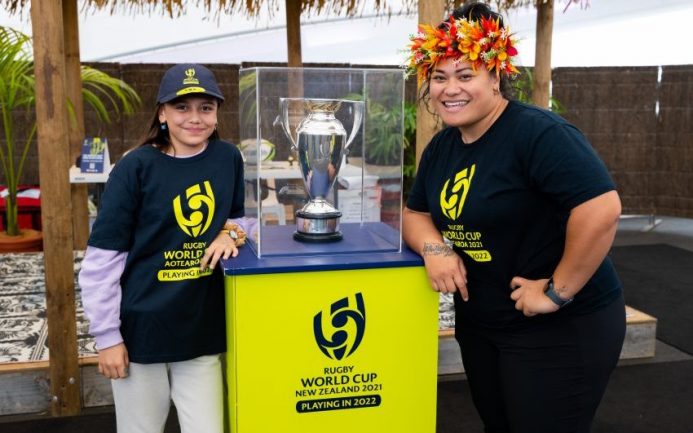First a reminder of the draw for the RWC:
Pool A New Zealand Australia Scotland Wales
Pool B Canada USA Italy Japan
Pool C France England Fiji South Africa
A Trophy called Nancy
‘Nancy’ is the name the Black Ferns have given the RWC trophy. It’s not your cuddly bear mascot to attract the youngsters, but a stark reminder of a dark episode in New Zealand’s past. Nancy Wake’s autobiography takes some believing. She was active throughout the Second World War in France as a spy and resister. Unlike many of her kind she escaped capture right up to Germany’s capitulation in 1945. The Germans nicknamed her The White Mouse, the title of a biopic made about her. She was awarded the George Cross at the war’s end and lived to the age of 98. Her French husband was not so lucky. He was executed for his anti-German activities.
So the trophy’s nickname takes on a special meaning for all New Zealanders, who can feel especially proud of her example.
The Draw
Do we like the draw? It pairs off nations that habitually play each other: Australia v New Zealand; Scotland v Wales; Canada v USA; France v England. So a reduced chance of a first ever meeting with Ruritania or some other exciting land you’ve never heard of. A pity. Do you travel halfway round the world to play a team that you’ve met umpteen times recently in your own backyard?
The system is based on banding or seeding, so that the top-ranked nations are kept apart as far as possible till the knock-out stages. Even so first-ranked England meet fourth-ranked France in Pool C in the second round.
World Rugby and the RWC committee have good reasons for keeping the number of qualifiers at 12, but it does mean these match-ups repeat themselves across the years.
For as long as the vast majority of players remain amateur, it will be hard to ensure they can stay on for a longer programme with 16 participating nations. Jobs must not be jeopardised.
South Africa, Wales and Italy have started out on the journey to professionalism; Ireland (non-qualifiers) are following soon. Funding remains a basic worry.
English spoken!
One feature that refuses to disappear fast: nine of the twelve nations have English as an official language. And English rules the roost on the field of play, bringing an immediate disadvantage to players who don’t at once understand what a referee is saying at any given moment. This is a quite unacceptable inequality.
The referee’s statements should be limited to the fewest possible: ‘Crouch, Bind, Set’ being an acceptable starting and finishing point.
Some Forecasts
England are the red-hot favourites with France snapping at their heels and New Zealand desperate to catch up on the ground lost in their tour of Europe last autumn.
Those three nations each have one more warm-up test. England should have little difficulty in seeing off Wales on 14 September, but France weren’t at their best facing Italy at home. A scoreless second half was certainly not on the menu. They play a return match on 9 September away. They will be anxious to turn in a top-class performance.
One disappointing feature of recent England games has been the reliance on a dominant pack to provide drive-over tries.
In the tightest games they have played, the two against France, they have struggled to set their backs free, That was a huge disappointment in Bayonne, but credit is due to the French for their line-speed and defensive powers.
The Black Ferns have added a third warm-up to their programme. They welcome Japan to Eden Park on 24 September. The Sakuras have rather tailed off in recent tests, so can’t be hopeful of victory. WR will be delighted to acknowledge Lesley McKenzie’s presence in their midst, a very rare female as a national head coach.
An away fixture might yet have been a better idea for the Ferns, if only to take them out of their comfort zone. Knowing that all their games will be supported by their own fans is a blessing they have never before enjoyed in World Cup history, but they might derive more benefit if they were taken away from familiar surroundings. Their latest performance against Australia left them some way short of their hoped-for standards.
Beyond those three favourites, Canada have the ability to turn in a performance. They need as much match practice as they can find, but have no fixtures left. Instead they became the first nation to publish their RWC squad. At their best they can dazzle: a powerful pack needs some stopping and the largely francophone backs can step. But lack of time together counts against them. (A feature all too common amongst the twelve competing nations). For their sake and the sake of the tournament we must hope they can repeat their heroics of 2014, where they reached the final.
The USA showed their strengths and weaknesses against England last weekend. They have match-turners especially up front. It was significant that their two most outstanding performers were responsible for their first try. Kate Zackary (captain and No 8) made the break to the English line for Hope Rogers (No 1) to score yet another try. Tries against the world’s top rankers are real achievements.
But there’s an obvious need for more control beyond Nos 8 and 1, and there lies their difficulty. Rob Cain was right to say post-match that they ‘punch’ way above their weight, but their extreme amateur status counts against them.
Australia
As so often the Wallaroos are having to play catch-up as Rugby Australia refuses to support them properly, claiming lack of copper coins as their principal excuse. Their showing in Adelaide, where they went down only 14-22 to the Black Ferns, shows just how good they could be with whole-hearted support.
Wales
No verdict is possible until we’ve seen them perform again against the Red Roses, but I suspect Ioan Cunningham is still hunting for players of real quality to lift the general standard. Carys Williams-Morris (5 England caps) becomes yet another test-player to take advantage of WR’s wise relaxation of eligibility rules. She will bolster Wales’ midfield alongside Hannah Jones who continues to stand out as the new captain.
Scotland will be delighted simply to be back at the top-table after a gap, but they remain inconsistent. They need all the bulk they can find to hold their own in the tight. Jade Konkel plays a central role there. Out behind experienced players, Helen Nelson, Lisa Thomson, Chloe Rollie and Megan Gaffney, can still fail to exploit promising positions. Rollie’s last-minute try to defeat Ireland was a classic case of everything working perfectly.
Unfortunately for the squad the tragic fate of Siobhan Cattigan and the SRU’s alleged lack of response to her condition, is a dragging weight that cannot easily be shuffled off.
They too have one more match to complete their preparations, against Spain, (another non-qualifier) at Edinburgh on 11 September. Bryan Easson is one more head coach who must set out careful targets for his players.
South Africa are on the way, but it will need a year or three more before they can take on the heavyweights with confidence. There is a lot of talent in the republic, and Lynne Cantwell has reorganised structures to ensure that all the best talent is identified early.
Italy are taking quite a while to turn promise into achievement. We await the result of their return match against France, but the odds don’t look great. They have fine players in their ranks, but not enough to turn games regularly in their favour. Andrea Di Giandomenico is gradually introducing new blood into his squad; they represent the Azzurre’s best chance of turning a corner to make victories more of a commonplace.
They can take credit for that scoreless second-half in Nice, but the fact remains they didn’t score a point.
The other exciting entrants to the 2022 RWC are Fiji. In those islands Sevens is the game of choice, they are spectacularly good at it, but their 15s squad is handicapped both by geography and the lack of funding to exploit their natural talent.
It would be lovely to think of them causing the Red Roses an embarrassment or two. Kiwi crowds would love that.









